Eduardo Garzón Aldás1*
1Dermatologist /Dermatopathologist, Clínica Dermatológica Garzón, Ecuador
*Correspondence author: Eduardo Garzón Aldás, Dermatologist /Dermatopathologist, Clínica Dermatológica Garzón, Ecuador; Email: [email protected]
Published Date: 13-05-2024
Copyright© 2024 by Garzon Aldas É, et al. All rights reserved. This is an open access article distributed under the terms of the Creative Commons Attribution License, which permits unrestricted use, distribution, and reproduction in any medium, provided the original author and source are credited.
Abstract
Epithelioid hemangioma or Angiolymphoid Hyperplasia with Eosinophilia (ALHE) is a rare benign vascular disease, characterized by solitary or multiple angiomatous papules and nodules, which are usually located on the skin of scalp and face (mainly in the preauricular zone); these have characteristic histological and immunohistochemical patterns, in particular characterized by an important lymphocytic inflammatory infiltrated with many eosinophils and vascular proliferation of capillaries with endothelial cellular changes. In this paper, four cases of this disease are reported, in the first series of Ecuadorian cases described in the literature.
Keywords: Angiolymphoid Hyperplasia with Eosinophilia; Face Scalp; Epithelioid Endothelial Cells
Introduction
Angiolymphoid Hyperplasia with Eosinophilia (ALHE) is a benign, rare and idiopathic entity, characterized by papules, plaques or nodules in the skin or in subcutaneous tissue [1,2]. These lesions may be single or multiple, sometimes grouped, with an erythematous, violaceous or brown color (3,4); they can be associated with itching, pain or pulsating sensations [2,5]. Approximately 85% are located in the head and neck, with a predilection for the periauricular area [1-4]. Although the pathogenesis is unknown, it has been considered as a reactive process to various stimuli, including vascular malformations, trauma or hormonal changes as in pregnancy [2-7]. However, there are several papers in which the clonality of various case of ALHE could be lymphoproliferative disorder of low grade rather than reactive processes [1-3,5,6,8,9]. The histology shows a well-defined area of vascular proliferation with large epithelioid endothelial cells with abundant eosinophilic cytoplasm, accompanied by an inflammatory infiltrate of lymphocytes and eosinophils [1,3,5,7]. Surgery had been considered to be the best treatment modality for ALHE, but the recurrence is frequent also, there are other modalities such as intralesional bleomycin, corticosteroids, propranolol, imiquimod and pulsed dye laser [10-18]. The objective of this paper is to report 4 new cases with focus on the clinical and histological characteristics of AHLE.
Cases
Table 1 shows the clinical characteristics of the four patients. There were three females and one male, aged between 32 and 62 years (mean 45 years); none had a significant personal or family history. The most frequent symptoms associated with the lesions were pain and pruritus, which appeared in 3 of the 4 cases, with 100% of the cases presenting multiple lesions such as papules and nodules, whose coalescence formed infiltrated erythematous-violaceous plaques. These plaques had an exudative, crusty and hyperkeratotic component in two patients (numbers 1 and 4), while the surfaces were smooth and shiny in the other two (numbers 2 and 3). In all patients, the lesions were located in the auricular and preauricular area with unilateral compromise (Fig. 1-4).
Systemic examination was normal in all and routine laboratory investigations did not show any abnormalities. Punch biopsy samples were taken in all four patients, whose histopathological findings were very similar in all cases and are summarized in Table 2. Intradermal lobular proliferation of vessels was observed, along with capillaries with lumens of different sizes, because the endothelial cells had epithelioid morphology and which were prominent towards the lumen, giving a plump shape, without cytological atypia. All of this was accompanied by a dense nodular and diffuse inflammatory infiltrate of lymphocytes and eosinophils and a few plasma cells, with lymphoid follicles observed (Fig. 5). The immunohistochemistry demonstrated a predominance of CD20+ lymphocytes (B lymphocytes) and some lymphocytes CD3+, CD45 RO-, CD30-, endothelial cells were positive to CD34 and FVIII (Fig. 6). Regarding the time of evolution, it was 1-3 years, with an average of 2.2 years. The therapeutic treatment in all patients was intralesional corticosteroids (triamcinolone acetonido), oral propranolol (2 mg/kg/d) and oral prednisone (1 mg/Kg/d); 3 patients had total remission of the lesions in a time range of 6 months, while only one case had a partial response. In a follow-up period of 5 years, two of the four patients showed recurrence of the disease, with a new, good response with the same treatment (Fig. 1-4).
|
Case |
Age/Sex |
Symptoms |
Type of Lesions |
Color |
Localization |
Other Sites |
Evolution Time |
Treatme Nt |
Response to Treatment |
|
1 |
42y/F |
Pruritus and Pain |
Nodules, Plaque |
E, V |
Auricular And Preauricular |
No |
3y |
IC+OC+P |
PR |
|
2 |
44y/F |
Pruritus and Pain |
Papules, Plaque |
E |
Preauricular |
No |
1y |
IC+OC+P |
TR |
|
3 |
32y/F |
Asymptomatic |
Nodules, Plaque |
E |
Auricular |
No |
2y |
IC+OC+P |
TR |
|
4 |
62y/M |
Pruritus and Pain |
Plaque |
E |
Auricular |
No |
1y |
IC+OC+P |
TR |
|
E = Erythematous; V = Violaceous; IC = Intralesional Corticosteroids; OC = Oral Corticosteroids; P = Oral propranolol; PR = Partial Response; TR = Total Response |
|||||||||
Table 1: Clinical data of the four patients.
|
Case |
Dermal Compromise |
TCS Compromise |
Vascular Proliferation |
Inflammatory Infiltrated |
Lymphoid Follicules |
|
1 |
Yes |
Yes |
+++ |
E:++L:+++P:+M:- |
Yes |
|
2 |
Yes |
No |
++ |
E:+L:++P:-M:- |
No |
|
3 |
Yes |
No |
+++ |
E:+L:+++P:-M:- |
Yes |
|
4 |
Yes |
No |
++ |
E:+L:++P:+M:- |
No |
|
TCS = Subcutaneous Tissue; + = mild; ++ = moderate; +++ = intense; E = Eosinophils; L = Lymphocytes; P = Plasma cells; M = Mastocytes |
|||||
Table 2: Histopathological data.
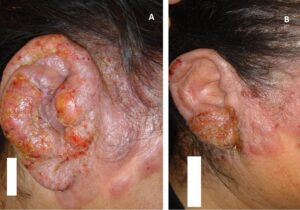
Figure 1: A: Patient # 1 with papules and nodules, whose coalescence formed infiltrated erythematous-violaceous and exudative plaques; B: A decrease in the infiltration is observed with treatment, mainly in auricular area.
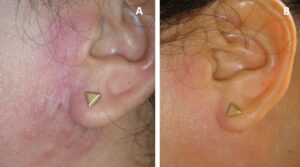
Figure 2: A: Patient # 2 Tender and erythematous nodules in the preauricular zone; B: Significant improvement after treatment.
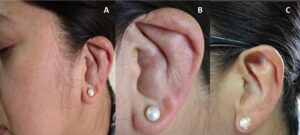
Figure 3: A: Patient #3 with compromise of her auricular zone; B: zoom of this area with compromise of the external auditory canal. C: Resolution after treatment.
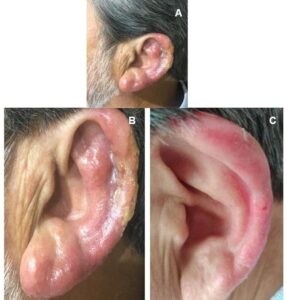
Figure 4: A: Patient # 4: Left ear with large infiltration of the earlobe and helix; B: Detail of the lesion; C: Improvement with persistent erythema after treatment.
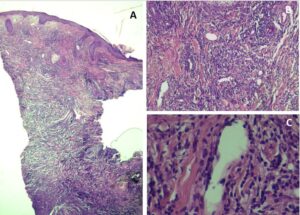
Figure 5: A: (H_E 4 x) Diffuse and nodular dermal superficial and deep perivascular infiltrate; vessels are ectatic; B: (H-E 10x) A cellular infiltrate composed by lymphocytes and sparse eosinophils with proliferating vessels; C: (H-E 40x) A higher resolution shows the lesion consisted of vessels lined by plump endothelial cells and surrounding lymphocytes and sparse eosinophils.
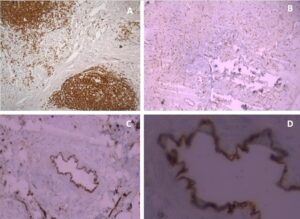
Figure 6: Immunohistochemistry. A: (10X) CD20 immunocoloration evidenced the presence of lymphoid follicles; B. (4 x) CD34 positivity in endothelial cells in many dermic vessels; C: (40X) CD34 positivity in plump endothelial cells; D: (100X) Detail of them.
Discussion
ALHE, also known as epithelioid hemangioma, is a rare benign vascular proliferating disease of the skin, mainly of the neck, face (periauricular areas 36.3%) and head there is a female preponderance, with an average age of 35 years old as shown in this case series, without racial differences [1-4]. Unusual localizations of ALHE have been reported, such as in the hands, oral mucosa (mainly in males) trunk or penis the patients discussed here presented the most frequently seen locations: the auricular and preauricular areas [5-7,10,15]. The lesions typically present as single or multiple well-defined papules or nodules which, when joined together, can form plaques that are red, brown or purple in color [1,2,8-12]. When the lesions have a very important inflammatory component, the surface of the lesions can show exulcerations and exudative fluid, as in patients 1 and 4 [1,2,13,15]. Pain, pruritus, regional lymphadenopathy and pulsatile sensations are among the main symptoms and signs the patients presented here referred only pain and pruritus [1-5,10,13].
The exact pathogenesis of ALHE remains unknown; however, a proliferation of endothelial cells in response to different stimuli such as trauma or inflammation preexisting vascular malformation hormonal changes, manly in perimenopausal or postgravidic women or in association with the use of oral contraceptives have all been suggested [1-8]. In this series of cases, no related factors were identified.
The histopathology revealed proliferation of the vessels, with large endothelial cells that contain an abundant eosinophilic cytoplasm and which are mostly cuboidal with cytoplasmic vacuolation and lobulated nuclei; these cells project towards the capillary lumen, giving the shape of plump cells [1,2,4,5,12]. A dense vascular and interstitial infiltrate of eosinophils and lymphocytes is seen. These histological changes are seen in the dermis and less frequently in subcutaneous tissues as in the four patients reported here [1,2,4,5]. The immunohistochemical exams show positivity of the endothelial cells for von Willebrand factor, CD31 and CD34 and CD20 positivity for B lymphocytes [1,2,4,5,8].
The main clinicopathological differential diagnoses are Kimura disease, pyogenic granuloma, epithelioid hemangioendothelioma, Kaposi sarcoma, angiosarcoma, cutaneous epithelioid angiomatous nodule, lymphomas and skin metastases [1,2,4,5,8-10,14,15].
Dermoscopic features of ALHE are described in 3 case reports, with features of a polymorphous vascular pattern composed of dotted, corkscrew and irregular-linear vessels arranged radially over a diffuse pale reddish background [12,13]. The gold standard treatment for ALHE is radical surgical excision, however, these lesions can also be treated by systemic corticosteroids intra-lesional injection of corticosteroids [or sclerosing agents, cryotherapy pulsed-dye laser treatment carbon dioxide laser treatment, photodynamic therapy, interferon alpha-2 therapy, isotretinoin and tacrolimus [1,2,3,12-18]. The treatment chosen for the four patients in this study was oral prednisone + intralesional triamcinolone acetonido + oral propranolol; no reports on the use of the latter in ALHE were found, but it was selected here based on its pharmacological action in other proliferative vascular disorders such as hemangiomas [16]. ALHE tends to show a chronic and non-remittent pathology, but there are reports of expontaneous involution; its treatment is therefore guided by the number and size of the lesions and the patient’s general health [11].
Conflict of Interests
The authors declare that there is no conflict of interest for this paper.
References
- Zou A, Hu M, Niu B. Comparison between Kimura’s disease and angiolymphoid hyperplasia with eosinophilia: case reports and literature review. J Int Med Res. 2021;49(9):3000605211040976.
- Grünewald M, Stölzl D, Wehkamp U. Role of Eosinophils in Angiolymphoid Hyperplasia with Eosinophilia. JAMA Dermatol. 2021 ;157(10):1241-3.
- Brahs A, Sledge B, Mullen H. Angiolymphoid hyperplasia with eosinophilia: Many syllables, many unanswered questions. J Clin Aesthet Dermatol. 2021;14(6):49-54.
- Asano A, Kusutani N, Sowa-Osako J. Intravascular angiolymphoid hyperplasia with eosinophilia in the bilateral periauricular regions: A case report. J Dermatol. 2021;48(1):e13-4.
- Tamabuchi E, Fujimura T, Lyu C, Aiba S. Multiple angiolymphoid hyperplasia with eosinophilia on the right arm showing unusual presentation. Dermatol Ther. 2020;33(6):e14314.
- Yaghoobi R, Pourriahi K, Pazyar N, Hamedpour R. Angiolymphoid hyperplasia with eosinophilia along with arteriovenous malformation: an unusual case. Indian J Dermatol Venereol Leprol. 2022;88(2):216-8.
- Cenk H, Kapicioglu Y, Sarac G, Sener S, Sahin N. Recurrent angiolymphoid hyperplasia with eosinophilia during several pregnancies. Dermatol Online J. 2020;26(8):13030.
- Ishii A, Watanabe S, Nishihara C. Previously unreported permanent tattoo- associated angiolymphoid hyperplasia with eosinophilia/epithelioid hemangioma. Pathol Int. 2021;71(3):219-21.
- Lin YL, Chu GY. Time from injury to tumor onset in patients with angiolymphoid hyperplasia with eosinophilia: A case report and literature review. Indian J Dermatol. 2021;66(4):405-7.
- Markidan J, Hardy N, Kallen M, Ma L. Epithelioid hemangioma involving large arteries in the skin. J Cutan Pathol. 2022;49(4):377-80.
- Slimani Y, Hali F, Sid’Ahmed Tolba C. Spontaneous regression of Angiolymphoid Hyperplasia with Eosinophilia (AHLE): A case report. Ann Med Surg (Lond). 2021;66:102376.
- Akay BN, Fatih Atak M, Farabi B. Dermoscopic features of two cases of angiolymphoid hyperplasia with eosinophilia and review of the literature. Dermatol Pract Concept. 2021;11(2):e2021003.
- Kalantri M, Khopkar U. Spectrum of dermoscopic pattern in a patient with angiolymphoid hyperplasia with tissue eosinophilia. Indian J Dermatol. 2020;65(6):556-8.
- Torres Fuentes CE, López González PA. Angiolymphoid hyperplasia of the external auditory canal; Reconstruction of a complex defect. Ear Nose Throat J. 2023;102(9):NP423-5.
- Granieri G, Oranges T, Panduri S. Unusual presentation of angiolymphoid hyperplasia with eosinophilia treated with intralesional and topic corticosteroid combination therapy. Dermatol Reports. 2021;13(2):9063.
- Emna B, Mohamed BR, Ben Youness K. Successful treatment of angiolymphoid hyperplasia with eosinophilia with oral propranolol in two cases. Dermatol Ther. 2021;34(4):e14994.
- Galili E, Levi A, Lapidoth M. Percutaneous ethanol sclerotherapy is a promising treatment for recalcitrant angiolymphoid hyperplasia with eosinophilia. Clin Exp Dermatol. 2022;47(3):568-72.
- Huff S, Pootrakul L, Sopkovich. Treatment of angiolymphoid hyperplasia with eosinophilia with pulsed dye laser. J Dermatol Surg. 2021;47(4):570-2.
Article Type
Case Report
Publication History
Received Date: 11-04-2024
Accepted Date: 05-05-2024
Published Date: 13-05-2024
Copyright© 2024 by Garzon Aldas É. All rights reserved. This is an open access article distributed under the terms of the Creative Commons Attribution License, which permits unrestricted use, distribution, and reproduction in any medium, provided the original author and source are credited.
Citation: Garzon Aldas É. Epithelioid Hemangioma: Report of a Case Series of 4 Patients. J Dermatol Res. 2024;5(2):1-7.

Figure 1: A: Patient # 1 with papules and nodules, whose coalescence formed infiltrated erythematous-violaceous and exudative plaques; B: A decrease in the infiltration is observed with treatment, mainly in auricular area.

Figure 2: A: Patient # 2 Tender and erythematous nodules in the preauricular zone; B: Significant improvement after treatment.

Figure 3: A: Patient #3 with compromise of her auricular zone; B: zoom of this area with compromise of the external auditory canal. C: Resolution after treatment.

Figure 4: A: Patient # 4: Left ear with large infiltration of the earlobe and helix; B: Detail of the lesion; C: Improvement with persistent erythema after treatment.

Figure 5: A: (H_E 4 x) Diffuse and nodular dermal superficial and deep perivascular infiltrate; vessels are ectatic; B: (H-E 10x) A cellular infiltrate composed by lymphocytes and sparse eosinophils with proliferating vessels; C: (H-E 40x) A higher resolution shows the lesion consisted of vessels lined by plump endothelial cells and surrounding lymphocytes and sparse eosinophils.

Figure 6: Immunohistochemistry. A: (10X) CD20 immunocoloration evidenced the presence of lymphoid follicles; B. (4 x) CD34 positivity in endothelial cells in many dermic vessels; C: (40X) CD34 positivity in plump endothelial cells; D: (100X) Detail of them.
Case | Age/Sex | Symptoms | Type of Lesions | Color | Localization | Other Sites | Evolution Time | Treatme Nt | Response to Treatment |
1 | 42y/F | Pruritus and Pain | Nodules, Plaque | E, V | Auricular And Preauricular | No | 3y | IC+OC+P | PR |
2 | 44y/F | Pruritus and Pain | Papules, Plaque | E | Preauricular | No | 1y | IC+OC+P | TR |
3 | 32y/F | Asymptomatic | Nodules, Plaque | E | Auricular | No | 2y | IC+OC+P | TR |
4 | 62y/M | Pruritus and Pain | Plaque | E | Auricular | No | 1y | IC+OC+P | TR |
E = Erythematous; V = Violaceous; IC = Intralesional Corticosteroids; OC = Oral Corticosteroids; P = Oral propranolol; PR = Partial Response; TR = Total Response | |||||||||
Table 1: Clinical data of the four patients.
Case | Dermal Compromise | TCS Compromise | Vascular Proliferation | Inflammatory Infiltrated | Lymphoid Follicules |
1 | Yes | Yes | +++ | E:++L:+++P:+M:- | Yes |
2 | Yes | No | ++ | E:+L:++P:-M:- | No |
3 | Yes | No | +++ | E:+L:+++P:-M:- | Yes |
4 | Yes | No | ++ | E:+L:++P:+M:- | No |
TCS = Subcutaneous Tissue; + = mild; ++ = moderate; +++ = intense; E = Eosinophils; L = Lymphocytes; P = Plasma cells; M = Mastocytes | |||||
Table 2: Histopathological data.


